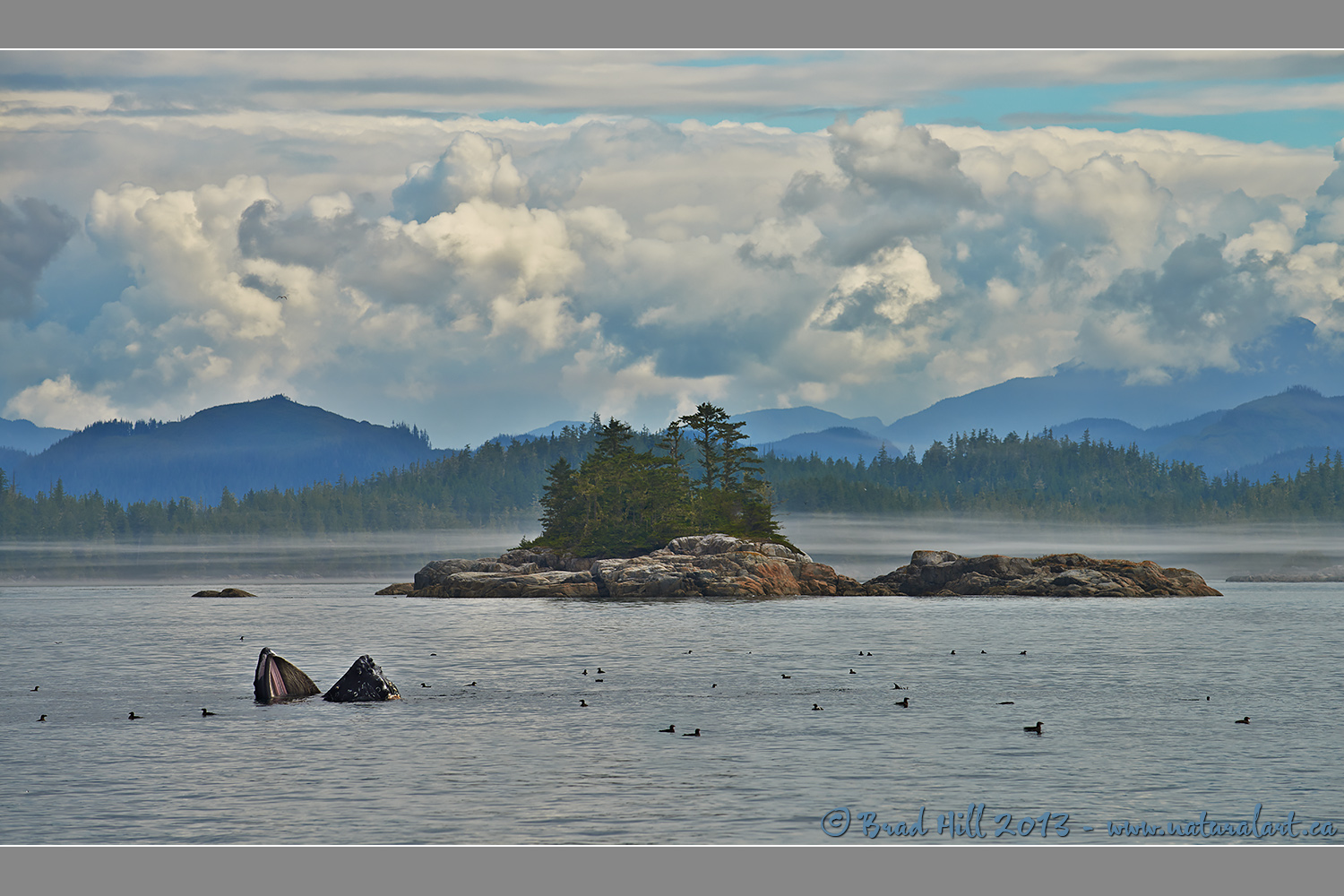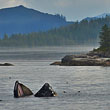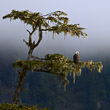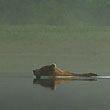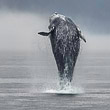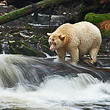Availability: Limited Edition Print - info coming soon!
In the Field
An August Oceanscape. Blackfish Sound (northern Vancouver Island, BC). August 19, 2013.
I captured this expansive animalscape* on a misty, moody morning in August of 2013 while on my annual "Humpbacks, Orcas, Sea Lions and More" photo tour. I went on this trip with a bit of a different mindset than normal - I was determined to resist the urge of almost all wildlife photographers to always "get closer". So I intentionally made myself "back off" (at least in focal length) and shoot more animalscape shots. This was partly because I went on the trip wanting to do more testing of Nikon's top pixel monster of the day (the D800e) - a camera with tons of resolution and, just as importantly, a super-wide dynamic range. In other words, I finally had a Nikon camera in my hands that - if carefully used - could do justice to animalscape and landscape shots. My urge to shoot more 'scapes on this trip was also a result of past history - I knew the area we were visiting had very abundant wildlife and they often situated themselves in front of jaw-dropping natural backdrops (as long as you have a capable and photography-friendly skipper expertly positioning your craft - thanks a bunch Chris!). As anyone who has tried to shoot animalscape shots knows, a lot of factors have to come together for the shots to really work. I know of no other region that so regularly delivers up all the factors needed for great animalscapes.
We intentionally sought out this location on this morning. We knew the small rocky islands were often blanketed with soft mist - and we also knew that the amount of feed in the water often attracted Humpback Whales (and a lot of seabirds that also keyed in on the feed). What we hadn't counted on was encountering a humpback that had developed its own laid-back way of feeding. For those that don't know, humpbacks are filter-feeders that often capture their small prey by lunging at the surface of the ocean - an activity that is dramatic and must consume a whole lot of energy. This whale, in contrast, utilized the new and improved method of feeding known as the "lollygag" technique - it simply floated vertically with its mouth wide open and passively drifted around. Now I don't know how successful this new-fangled fishing technique was, but I can attest to the fact that the whale didn't waste a whole lot of energy in trying it out (and...who knows - maybe this whale was just bagging a few Z's and figured he/she might as well try to nab a snack along the way!). What I do know is that this "lazy" behaviour on the part of the humpback sure did make it a whole lot easier to compose the image than if it was doing "normal" lunge feeding!
This is one of those images that pretty much needs to be seen in a large version to be appreciated - the full resolution version is 7360 pixels wide and even viewing it at 1200 pixels is a little less than satisfying. So...just for your viewing pleasure - here's a 2400 pixel version of it:
• An August Oceanscape: Download 2400 pixel image (JPEG: 735 KB)
ADDITIONAL NOTES:
1. This image - in all resolutions - is protected by copyright. I'm fine with personal uses of it (including use as desktop backgrounds or screensavers on your own computer), but unauthorized commercial use of the image is prohibited by law. Thanks in advance for respecting my copyright!
2. Like all wildlife photographs on this website, this image was captured following the strict ethical guidelines described in The Wildlife FIRST! Principles of Photographer Conduct. I encourage all wildlife photographers to always put the welfare of their subjects above the value of their photographs.
3. This image was captured during my "Humpback, Orcas, Sea Lions & More" photo tour in August of 2013. Each year I offer trips into two different parts of the Great Bear Rainforest as well as one to photograph aquatic mammals and oceanscapes near the northern tip of Vancouver Island. And, in selected years, I also offer photo tours to locations to capture other highly sought-after subjects, such as various owl species of the boreal forest and wildlife of Canada's Arctic. Details about these trips can be found on the Photo Tours page of this website.
*4. For a more detailed discussion of the image types I call animalscapes and enviroscapes (and the subtle distinctions between them), just go here...
Behind the Camera
An August Oceanscape. Blackfish Sound (northern Vancouver Island, BC). August 19, 2013.
Digital Capture; Compressed RAW (NEF) 14-bit format; ISO 100.
Nikon D800e paired with Nikkor 70-200mm f4 VR lens at 185mm. Hand-held from floating sailboat. VR on and in normal mode.
1/400s @ f18; No compensation from matrix-metered exposure setting.
At the Computer
An August Oceanscape. Blackfish Sound (northern Vancouver Island, BC). August 19, 2013.
RAW Conversion to 16-bit TIFF, including first-pass/capture sharpening using Capture One Pro version 7. Three raw variants (different versions of a single raw capture) differing by a total of 0.5 stops in total exposure.
Further digital corrections on resulting 16-bit TIFF files using Adobe's Photoshop CC and Light Craft's LightZone. Photoshop adjustments included compositing/blending of the three exposure variants, very minor colour tweaks (hue rotation and desaturation of selected colours), further selective exposure tweaks and selective contrast adjustment, and selective sharpening for web output. Final tone tweaking performed using tonemapper/re-light tool in LightZone.
Conservation
An August Oceanscape. Blackfish Sound (northern Vancouver Island, BC). August 19, 2013.
Ten percent of the revenue generated by this image will be donated to Raincoast*.
Species Status in Canada**: Threatened - North Pacific population (May 2003).
Humpback Whales (Megaptera novaeagnliae) are active, acrobatic whales that can throw themselves completely clear of the water (a behaviour known as breaching) and will swim on their backs with both flippers in the air. Humpbacks are large (up to 14m - or 46 feet - in length and 40 tonnes in weight) and with huge flippers.
Humpbacks are found in tropical, temperate, and sub-polar waters around the world. They are found on both the east and west coasts of North America. The North Pacific population has been estimated at between 6,000 and 8,000 individuals, but only a few hundred of these are found in the waters off the coast of British Columbia.
While Humpbacks are recovering from the damage done to their populations by commercial fishing, the are still subject to a variety of threats from human activities, including becoming entangled in fishing nets, noise and chemical pollution and habitat destruction.
*The Raincoast Conservation Society (and Foundation) is an effective and efficient organization that has been fighting for protection of this unique habitat. If you are looking for a meaningful way to contribute to the conservation of this amazing ecosystem, Raincoast will provide maximal "bang" for your conservation dollars.
**as determined by COSEWIC: The Committee on the Status of Endangered Wildlife in Canada













